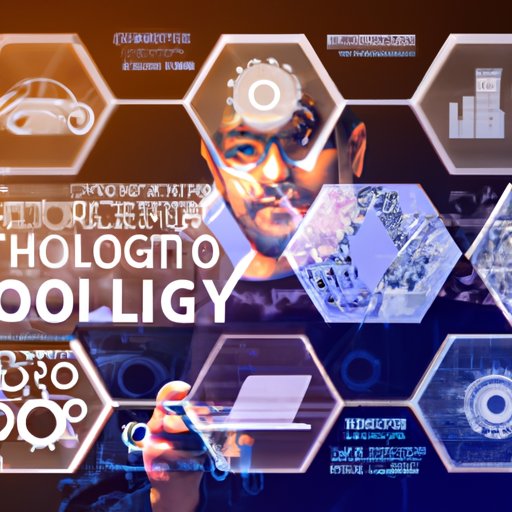Introduction
Advanced technology is a broad term that refers to any kind of technology that is more sophisticated than what is currently available. This can include everything from automation and robotics to artificial intelligence (AI) and big data analytics. Advanced technologies are used in many industries to improve productivity, enhance user experience, and increase safety. In this article, we will explore the benefits, impacts, and trends of advanced technologies.
Benefits of Advanced Technologies
The use of advanced technologies has numerous benefits. For businesses, they can lead to increased productivity by streamlining processes and eliminating manual labor. Automation and robotics can replace human workers in certain tasks, allowing businesses to save time and money. Additionally, advanced technologies can enhance the user experience for customers by providing more efficient services and better customer support.
Advanced technologies can also help improve safety. For example, self-driving cars have the potential to reduce the number of automobile accidents. Similarly, AI-powered facial recognition systems can be used to improve security in public places. By incorporating advanced technologies into safety protocols, companies can ensure that their employees and customers remain safe.
Impact of Advanced Technologies on Society
The use of advanced technologies has had a significant impact on society. One of the most notable effects is the increased access to information and services. With the advent of the internet and mobile devices, people can now access virtually any kind of information or service with just a few clicks. This has enabled businesses to reach a wider range of customers and offer more specialized services.
Advanced technologies have also led to the development of new markets and industries. For instance, the emergence of e-commerce platforms has created an entirely new way of doing business. Similarly, the use of big data and analytics has allowed companies to gain insights into their customers’ behaviors and preferences, enabling them to create more tailored products and services.
Finally, advanced technologies have changed the dynamics of the labor force. Automation and AI have replaced certain roles, while new jobs have been created in other areas. This has resulted in a shift in the skills and qualifications required for certain positions, as well as changes in the structure of the workforce.

How Advanced Technologies are Changing Industries
Advanced technologies have had a major impact on various industries. Automation and robotics have replaced certain manual labor tasks, allowing businesses to become more efficient and productive. Artificial intelligence systems are being used in healthcare, finance, and retail to collect and analyze data in order to make decisions and provide personalized services. Big data and analytics are being used to gain insights into customer behavior and preferences, as well as to identify potential opportunities for growth.
Additionally, the use of advanced technologies has enabled businesses to become more agile and responsive to changing market conditions. Companies can now quickly adapt to changes in customer demand and develop new products and services in response. This has allowed them to stay competitive and remain profitable in an ever-evolving marketplace.

Challenges of Implementing Advanced Technologies
Although advanced technologies can have numerous benefits, there are also several challenges associated with their implementation. One of the biggest challenges is the cost associated with implementation. Advanced technologies can be expensive to purchase and install, and there may also be additional costs associated with training staff and maintaining the systems.
Another challenge is overcoming resistance to change. Many people may be reluctant to embrace new technologies, particularly if it involves replacing existing systems. Companies must be able to effectively communicate the benefits of the technology and convince employees and customers of its value.
Finally, security and privacy must be taken into consideration when implementing advanced technologies. Companies must ensure that their systems are secure and protect the data they collect. They must also comply with relevant regulations regarding the storage and use of personal data.
Trends in Advanced Technologies
There are several emerging trends in the field of advanced technologies. Cloud computing is becoming increasingly popular, as it allows companies to store and access data remotely. The Internet of Things (IoT) is also gaining traction, with devices connected to the internet providing real-time data and insights. Wearable technology is also growing in popularity, as it allows users to monitor their health and activity levels.
Future of Advanced Technologies
As advanced technologies continue to evolve, new applications and possibilities will emerge. Automation and robotics are expected to become even more sophisticated, with machines performing more complex tasks. AI and machine learning will continue to expand, with these technologies being used to automate more processes and make better decisions.
In addition, there is likely to be an increased focus on sustainability. Companies are beginning to realize the importance of reducing their environmental impact, and advanced technologies can help them to achieve this goal. For example, renewable energy sources such as solar and wind can be used to power factories and reduce emissions.
Conclusion
Advanced technologies have had a profound impact on our lives, bringing numerous benefits and changing the way we live and work. They have enabled us to become more productive and efficient, while also providing us with better user experiences. Additionally, advanced technologies have enabled businesses to become more agile and responsive to changing market conditions. However, there are also challenges associated with implementing these technologies, such as the costs associated with implementation and ensuring security and privacy.
Looking ahead, advanced technologies are likely to become even more prevalent in our lives. Automation and robotics will continue to advance, while AI and machine learning will become increasingly important. Sustainability will also become a priority, as companies strive to reduce their environmental impact. As these trends continue to progress, it is clear that advanced technologies will remain a key part of our world for years to come.
(Note: Is this article not meeting your expectations? Do you have knowledge or insights to share? Unlock new opportunities and expand your reach by joining our authors team. Click Registration to join us and share your expertise with our readers.)
